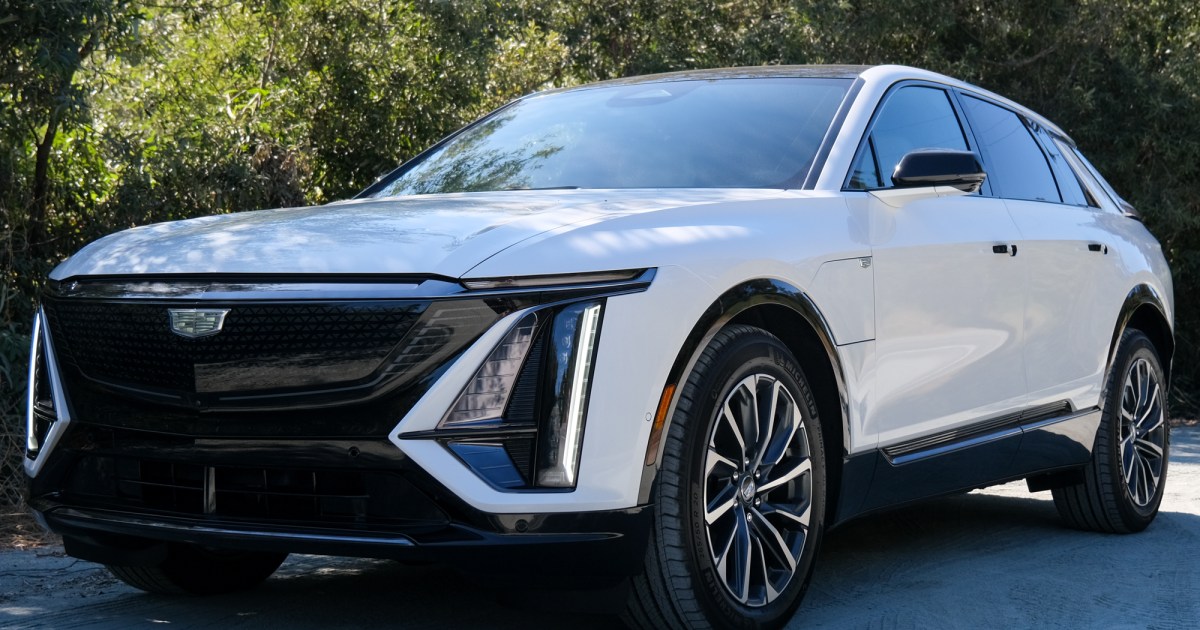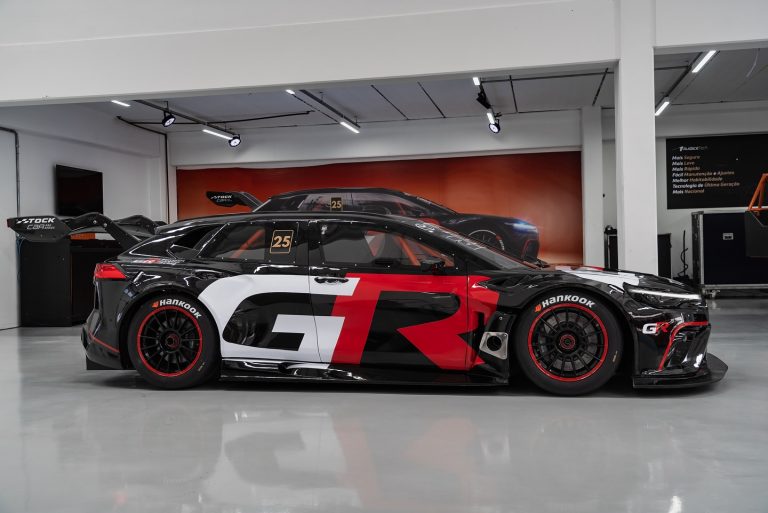2024 Cadillac Lyriq review: setting the stage

2024 Cadillac Lyriq review: setting the stage
MSRP $58,590.00
“With the Cadillac Lyriq, it’s great to see a vehicle that doesn’t require spending more cash on options to improve range.”
Pros
- Sleek design
- Comfortable interior
- Solid range
- Still has CarPlay
- Helpful driver-assist features
Cons
- A little pricey
- Slow to charge
While the likes of Ford, Hyundai, and Kia were relatively quick to switch to electrification for at least some of their vehicles, others weren’t quite as speedy. Cadillac, for example, held off for some time, announcing the Cadillac Lyriq in 2020 as a 2023 model year vehicle. Early on in the Lyriq’s lifespan, the car was incredibly difficult to get a hold of, and even now, there are supply issues, though those are finally starting to ease up.
The Lyriq is more than just Cadillac’s first EV. Like so many other automakers, Cadillac took the opportunity of releasing its first EV to introduce a new design language meant to represent Cadillac’s vision for the future. Not only that, but the Lyriq packs in new tech and features that make the experience of driving a Cadillac more modern than before.
A little over a year into the Lyriq being on the road, how does it hold up in an increasingly competitive EV space? I recently had the chance to drive the Cadillac Lyriq Sport 3 for a week to find out.
Design and interior
As mentioned, Cadillac took the opportunity of the Lyriq to introduce a new design language for its electrified vehicles. To be clear, the Lyriq certainly offers design elements of previous Cadillac cars. For example, it has that large Cadillac grille on the front, though for the Lyriq, it’s a faux grille rather than a real one. It also has the vertically aligned headlights that have become a staple of Cadillac design. I really like the overall look of the Lyriq, even with the faux grille. I’m driving a white model, and the black0and-white look is a nice one.

The back of the vehicle is just as interesting. It has angled taillights that extend down from the back of the roofline, then curve around the rear of the vehicle. The two sides don’t quite meet in the middle for a full light bar, but it’s still a sleek and modern look.
The interior of the vehicle is great too. It’s luxurious and modern-looking, and it doesn’t verge on getting overly gaudy, which is always nice to see in cars that are meant to be luxury vehicles. The Lyriq features strong and soft-feeling leather upholstery, under which there’s seat heating, seat cooling, and massaging. Again, the seats are highly comfortable.

The Lyriq offers plenty of space for most people as well. There’s a decent amount of room in the second row of seats, and you’ll get a large, open trunk that I found offered plenty of space for large items like a stroller. The trunk has 28 cubic feet of cargo room, which is a solid amount.
Ultimately, design is subjective, but again, I quite like the look of the Lyriq and find that the interior is comfortable and luxurious. It’s not over-the-top, but it’s certainly premium.
Tech, infotainment, and driver assist
The Lyriq doesn’t just offer a new design — it’s also packed with tech that makes the experience of driving it more modern and more convenient.
The star of the show is the expansive display at the front that stretches along the dashboard. This display joins the instrument monitor and the infotainment screen into one, and even offers a touch panel on the far left side for the driver to customize what’s shown on the instrument panel. For example, you can switch between the instrument panel showing map features, driver assist features, or simply instrument gauges. It’s a nice approach, though I suspect most people will pick their favorite view and stick with it without needing constant access to these settings.

The software experience on the Lyriq isn’t terrible, but it’s not incredible either. The software on the second-generation Rivian R1S that I recently drove is far superior to what’s on offer in the Lyriq. It’s a bit of a shame because, as a GM company, Cadillac is slowly moving away from offering CarPlay, though the Lyriq that I drove did still have CarPlay built into it. The software is laid out much like a phone, with buttons to access most of the major functions arranged in a grid. There’s also a quick access menu bar at the bottom of the screen that allows you to switch between things like maps, music, and car information. I did find that the software was decently responsive compared to other vehicles, though still not as responsive as what you’ll find on a Tesla or Rivian.
Thankfully, there are some features that are not packed into the screens, like climate controls. Cadillac has resisted the urge to cram fan speed and temperature controls into the software, and you’ll still get physical paddles that are easy to control without taking your eyes off the road. It’s a safer and more convenient approach, and I hope others follow suit and reverse decisions to build everything into the software.

One of the standout features on the Lyriq is access to GM’s Super Cruise technology, which essentially allows for hands-free driving on the highway. Super Cruise differentiates itself from basic adaptive cruise control by not only allowing the vehicle to drive without the driver having to keep their hands on the wheel, but also with advanced features like automatic lane changing, which the car performs when it finds itself stuck behind a vehicle going slower than the maximum speed that the driver has set. I found that it worked quite well and was a little taken aback the first time the car changed lanes on its own. Again, the feature really only works on highways, and only on select highways — you can’t activate it in a zone that it’s not set up to work in. Other helpful driver-assist features include bird’s eye parking views and an actual adaptive cruise control that can be used in situations when the vehicle isn’t able to use Super Cruise.
Driving experience
I found the Lyriq to perform quite well overall. I was specifically driving the Cadillac Lyriq Sport 3, which is the highest-end version of the Lyriq. While the Sport 3 may offer design tweaks and some extra features compared to other versions, all iterations of the Lyriq perform the same. The Lyriq is available in rear-wheel drive and all-wheel drive configurations, and I was driving an all-wheel drive Lyriq.

The AWD Lyriq is very quick. The dual-motor setup delivers 500 horsepower and is able to accelerate from 0 to 60 miles per hour in around 4.6 seconds. To be clear, there are plenty of faster EVs out there, but years into test-driving EVs, I’m still excited every time I hit the accelerator and get that immediate response and fast acceleration. Most drivers will find it to be more than quick enough for maneuvers like fast overtaking on the highway and quickly getting up to speed on an entry ramp.
The Lyriq also offers excellent single-pedal driving options, and unlike some other modern vehicles, it saves previous settings for the next time you turn on the car. That may not sound like a big deal, but it’s definitely an added convenience that EV drivers will appreciate. In many day-to-day driving scenarios, I found that I never really had to touch the brake pedal when in one-pedal driving mode.

Generally, I found the steering of the Lyriq to be relatively responsive, and the car felt smaller than it actually is around tighter turns. There wasn’t much lean, either. The suspension makes the ride comfortable and smooth, though it certainly didn’t verge on being overly soft, and you’ll still feel bigger bumps as you go over them. That might make driving on rougher terrain a little less comfortable than in other vehicles, but overall, I found the Lyriq to be smooth.
Range and charging
The range of the Lyriq varies a little depending on whether you get an all-wheel drive version or a rear-wheel drive version — but not as much as you might expect. The rear-wheel drive Lyriq gets 314 miles of range, while the all-wheel drive configuration reduces that to 307 miles. It’s nice to see a vehicle that offers more than 300 miles of range in all configurations.

The Lyriq charges reasonably quickly too, though not as fast as the upcoming Cadillac Escalade IQ will. The Lyriq tops out at 190 kilowatts at a DC fast charger. The charging curve of the Lyriq appears to be a little different from some other EVs, and the car seems to take a little longer to fully charge than I would have liked to have seen. To get from 10% to 80%, it takes over 40 minutes, which is a little slow. Basically, what that means is that while the vehicle might reach 190kW at some point in its charge, for the most part, it’s charging at a much slower rate.
Like other EVs, it’s worth thinking long and hard about how you plan on charging a vehicle — in a best-case scenario, you’ll charge at home overnight.
How DT would configure this car
The Cadillac Lyriq is an excellent electric vehicle. It offers a sleek exterior, a luxurious interior, and a solid range overall. It’s not cheap, of course — after all, this is a luxury vehicle. To get even the base model of the car, you’ll pay $58,590. But if you’re willing to spend some cash on a more luxurious crossover-sized electric car than the likes of the Hyundai Ioniq 5 and Kia EV6, you’ll love what’s on offer with the Cadillac Lyriq.
It’s great to see a vehicle that doesn’t require spending more cash on options to improve range. The base model Lyriq is called the Cadillac Lyriq Tech, and it has the same range as other versions of the Lyriq. However, some people might want to spend the additional $4,000 to upgrade to the Cadillac Lyriq Luxury, which adds the Super Cruise driver assistance tech, a better speaker system, seat ventilation and massaging, and more. These are luxuries, to be clear, but the Lyriq in general is a luxury car, and if you want high-end features, it’s probably worth upgrading to the Lyriq Luxury.
Most people will not need to spend the extra money on the Cadillac Lyriq Sport, which costs another $500 or so and only really adds some minor design changes compared to the Luxury model. Many buyers will want to upgrade to the AWD powertrain too, which adds an additional $4,000 to the price. The AWD Cadillac Lyriq Luxury starts at $66,190. The AWD Cadillac Lyriq Sport 3 that we reviewed costs $74,815.
Source: www.digitaltrends.com






